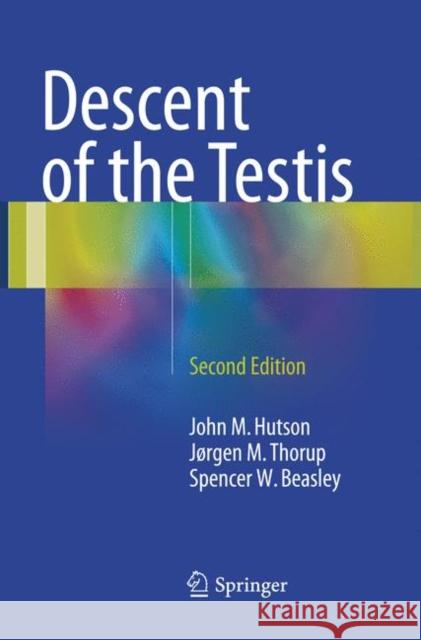Descent of the Testis » książka



Descent of the Testis
ISBN-13: 9783319798585 / Angielski / Miękka / 2018 / 178 str.
Descent of the Testis
ISBN-13: 9783319798585 / Angielski / Miękka / 2018 / 178 str.
(netto: 345,83 VAT: 5%)
Najniższa cena z 30 dni: 346,96
ok. 22 dni roboczych.
Darmowa dostawa!
"This new edition of the book presents a clearly written overview of all aspects of testicular descent, of cryptorchidism and its possible consequences. ... Each section is highly illustrated and well referenced. For pediatric endocrinologists and surgeons." (Pediatric Endocrinology Reviews, Vol. 13 (4), June, 2016)
"This slim volume attempts to present all that is currently known about the descent of the human testis and what problems of maldescent create as far as anatomical or physiological abnormalities of size, function, or location. ... This can be useful to students, house officers, and attending surgeons. ... This book will answer most any question about this topic. This updated edition will probably serve admirably as a standard reference for some years to come." (Robert M. Arensman, Doody's Book Reviews, March, 2016)
Introduction.- Evolution of Descent of the Testis and Early History of Research.- Transabdominal Migration of the Testis.- InguinoScrotal Descent of the Testis .- Classification and Causes of Undescended Tested in Humans.- Cryptorchidism and Associated Anomalies.- The Postnatal Effects of Cryptorchidism.- Diagnosis of Undescended Testis.- Operative Treatment.- Hormonal Treatment.- Results of Treatment.- Conclusions and Future Development.
John M. Hutson, MD, DSc, has been Chair of Paediatric Surgery in the Department of Paediatrics, University of Melbourne, Australia since 2006 and is a former Director of General Surgery at the Royal Children’s Hospital, Melbourne. Dr. Hutson has extensive clinical and research experience and has been the recipient of many awards during a career spanning four decades, including the Royal Australasian College of Surgeons Research Prize (2006), the Coe Medal from the Pacific Association of Pediatric Surgeons (2007), and the Sir Denis Browne Medal from the British Association of Paediatric Surgeons (2008). In 2004 Dr. Hutson accepted an Honorary Fellowship from the American Academy of Pediatrics (Surgical Section) and in 2007 he was made an Officer of the Order of Australia (AO). He has been Editor (Australasia) of Pediatric Surgery International since 2002 and Associate Editor of the Journal of Pediatric Surgery since 2003. His research has included detailed investigation into the regulation of testicular descent and disorders of sexual development. He is lead or co-author of more than 340 original papers in peer-reviewed journals and author or editor of 16 previous books, including Disorders of Sex Development: An integrated approach to management (Springer, 2012).
Jørgen Thorup, MD, PhD, has been Head of the Department of Paediatric Surgery, Rigshospital, University Hospital of Copenhagen, Denmark since 1995 and Chair of Paediatric
Surgery, Faculty of Health Science, University of Copenhagen, since 2006. Dr. Thorup is a Fellow of the European Board of Paediatric Surgery and of the European Academy of Paediatric Urology. He has been a member of the UEMS Joint Committee of Paediatric Urology (representative of the European Board of Paediatric Surgery) since 2003, and in 2011 became president of the committee. In 2014 he became an executive board member of the European Union Medical Specialists, Section of Paediatric Surgery. Dr. Thorup has been a speaker at numerous national and international congresses and is the author of more than 100 published articles as well as eight book chapters.This book provides a state of the art overview of all aspects of testicular descent and cryptorchidism, including the mechanisms of descent and the causes, consequences, diagnosis, and treatment of undescended testis. The advances in understanding that have been achieved over the past two decades are clearly explained, covering the latest genetic information on the causes of normal and abnormal testicular descent, the role of INSL3 in transabdominal migration, and the evidence that a neurotransmitter released from the genitofemoral nerve mediates androgenic control of inguinoscrotal descent. Exciting changes in the management of both congenital and acquired cryptorchidism, such as the widespread use of laparoscopy for impalpable testes inside the abdominal cavity, are fully described. Evidence for the benefits of orchidopexy within the first year of life is reviewed, and an individual chapter is also devoted to hormonal treatment. Throughout the book due attention is given to ongoing controversies and divergences of opinion. This new edition of Descent of the Testis will be a timely update and valuable reference for all who are involved in research into testicular descent and management of cryptorchidism.
1997-2026 DolnySlask.com Agencja Internetowa
KrainaKsiazek.PL - Księgarnia Internetowa









